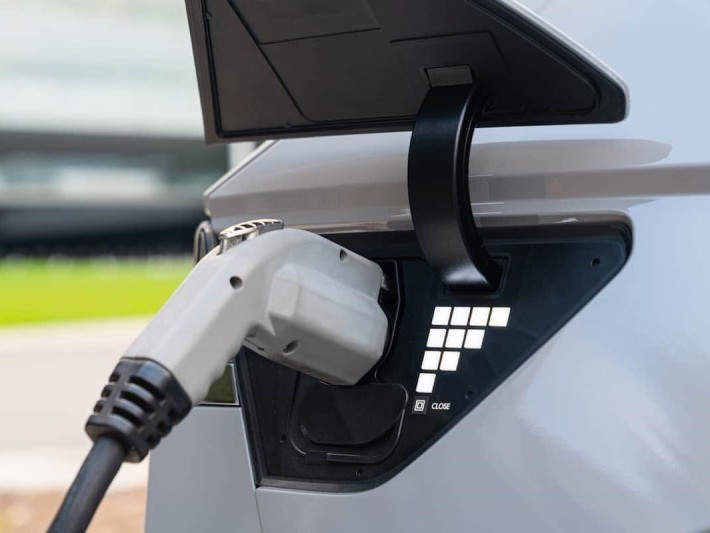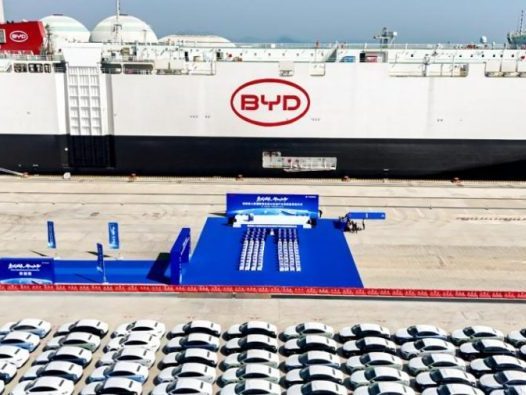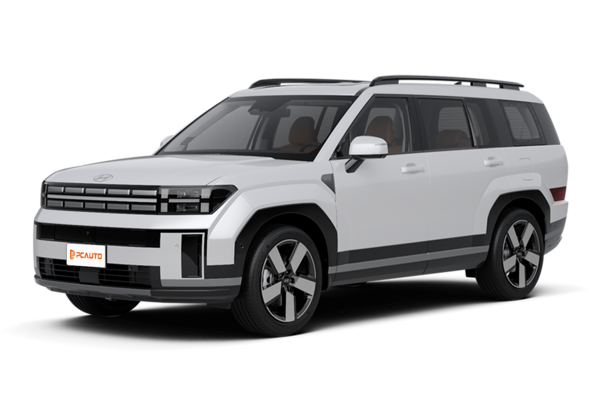Q
What are the colors of the 2025 Hyundai Santa Fe?
The 2025 Hyundai Santa Fe offers five stylish color options in the Malaysian market, each with its own distinct charm.
The Creamy White Pearl (WW2) is a classic pearlescent white that boasts an elegant sheen. It is an ideal choice for buyers who seek a noble and refined look. Moreover, this color can effectively reflect heat under Malaysia's scorching sun, keeping the interior of the car cool.
The Ecotronic Gray Pearl (PE2) is a fashionable gray shade with a pearlescent texture. It strikes a perfect balance between modernity and understatement, making it highly suitable for consumers who prefer neutral colors. Additionally, gray is relatively easy to maintain on a daily basis as it doesn't show dirt easily.
The Abyss Black Pearl (A2B) is a deep, lustrous black with a pearlescent glow. It exudes a sense of stability and grandeur, making it particularly well-suited for business settings. However, regular waxing is required to maintain the smoothness and glossiness of the paintwork.
The Ocado Green Pearl (RN2) is a unique green pearlescent paint that combines individuality with elegance. It is a great option for car owners who love distinctive colors. Furthermore, green blends harmoniously with the natural environment.
The Earthy Brass Matte (YBM) is a matte copper tone that creates a very avant-garde and sporty visual effect. This color is relatively rare in the market and appeals to consumers who value personalization and a sense of trendiness. Nevertheless, matte paint requires special care to prevent scratches.
Regardless of the color chosen, the color schemes of the Hyundai Santa Fe have fully taken into account the aesthetic preferences and practical needs of Malaysian consumers.
Special Disclaimer: This content is published by users and does not represent the views or position of PCauto.
Related Q&A
Q
What engine will the 2025 Santa Fe have?
The 2025 Hyundai Santa Fe is expected to hit the Malaysian market with two powertrain options. There's a 2.5-liter naturally aspirated four-cylinder petrol engine churning out around 191 horsepower, and for those seeking more efficiency, a 1.6-liter turbocharged hybrid setup that delivers a combined 230 horsepower. This hybrid strikes a nice balance between punch and fuel savings, making it a solid fit for Malaysians' daily commutes and family outings.
The new Santa Fe might also come equipped with Hyundai's latest HTRAC all-wheel-drive system, which should do wonders for stability when the rains hit or the going gets a bit rough on those less-than-perfect roads. What's cool about the hybrid version is that it uses Hyundai's tried-and-tested TMED hybrid tech. The electric motor and engine work together seamlessly to cut down on fuel consumption, which is a big plus considering Malaysia's not-so-friendly fuel prices these days.
As a key player in Hyundai's SUV lineup, the Santa Fe has always been about balancing performance and practicality. The 2025 model takes that further with upgrades to sound insulation materials and chassis tuning, making it even more adept at handling Malaysia's diverse road conditions. If you're itching for the exact specs, keep an eye on Hyundai Malaysia's official website for future updates or swing by an authorized dealership to chat with their folks.
Q
What is the best trim for the 2025 Santa Fe?
The 2025 Santa Fe hits Malaysian shores with a range of trims, and let's cut to the chase: the top-dog Calligraphy is the one to beat if you're after the full package. It's loaded with all the luxury and tech you could ask for – think a crisp 12.3-inch fully digital instrument cluster, a panoramic sunroof that floods the cabin with light, supple premium leather seats, a handy HUD for keeping your eyes on the road, and Hyundai's complete SmartSense active safety suite. That means goodies like Highway Driving Assist and Remote Smart Parking – perfect for folks who want both comfort and that high-tech edge.
If your budget's a bit tighter, don't sleep on the mid-range Premium trim. It still keeps the core comfort features we all appreciate, like dual-zone auto climate control and a user-friendly 10.25-inch infotainment screen. Plus, you're not skimping on safety here – it comes standard with practical stuff like blind-spot monitoring and rear cross-traffic collision avoidance.
Now, living in Malaysia, we all know how brutal that tropical heat can be, so it does a number on both your car's cooling and the interior's longevity. Trust me, splurging on the ventilated seats and UV-protected glass (if they're available as options in those tropical packs) is money well spent. On the upside, the Santa Fe does come standard with a smart air-con system and seats upholstered in heat-resistant materials, which should handle our local conditions pretty well.
And let's talk about our roads – they can be a bit unpredictable. If you can swing it, go for the HTRAC all-wheel-drive version. It'll definitely give you more confidence when things get slippery, especially during those sudden downpours. Also, if you're stuck in KL or PJ traffic day in, day out, the hybrid variant might just be your new best friend. It strikes a nice balance between decent fuel economy and peppy power when you need it most.
Q
Does the 2025 Hyundai Santa Fe come in a plug-in hybrid?
The 2025 Hyundai Santa Fe does come with a plug-in hybrid (PHEV) variant, and let me tell you, this thing’s a solid mix of combustion and electric power. It gives you that sweet zero-emission driving when you’re in EV mode, but when the battery runs low, it seamlessly switches to hybrid – perfect for Malaysian folks who want to keep it green but still need to clock those long highway miles without range anxiety.
Under the hood, the Santa Fe PHEV is expected to pair a peppy turbocharged engine with an electric motor. We’re talking around 50 km of all-electric range, which is more than enough for your daily commute around the city. And hey, it supports fast charging too, so topping up won’t eat into your day.
For the Malaysian market, PHEVs like this aren’t just about being eco-friendly – they make financial sense too. You’ll score tax breaks from the government’s new energy vehicle incentives, plus you’ll burn less petrol, which means more cash stays in your pocket at the end of the month. Hyundai’s really upped its game with hybrid tech lately, and the Santa Fe PHEV is a great addition to their green lineup, giving buyers even more options.
If you’re into eco-conscious rides, it’s worth checking out rivals too. The Toyota RAV4 Prime and BYD Tang DM-i are also making waves here in Malaysia – both solid picks if you want to explore other PHEV or EV options.
Q
Does the 2025 Hyundai Santa Fe require premium gas?
For your daily drives in Malaysia, the 2025 Hyundai Santa Fe is perfectly happy sipping RON 95 petrol. Hyundai hasn't mandated higher octane fuels like RON 97 – their Smartstream turbo engine is specifically optimized to work well with our local fuel quality. RON 95 will deliver all the power and fuel efficiency you need for regular use.
Now, if you're often hitting the highway hard or carrying heavy loads, you *might* feel a tiny bit sharper throttle response with RON 97 in the short term, but honestly, over the long haul, the difference is pretty negligible. So, pick what works best for your driving style and wallet.
Just a quick heads-up: Malaysia's RON ratings aren't the same as, say, AKI in Europe or America. RON 95 here is your standard unleaded, while RON 97 is the premium (and pricier) option with better knock resistance. But don't get sucked into thinking higher octane is always better – keeping up with regular maintenance and avoiding dodgy petrol stations are way more important for your engine's health.
Hyundai has tweaked the engine management system specifically for Southeast Asia's climate and road conditions, so sticking to the manual's fuel recommendation is the sweet spot for balancing performance and running costs.
Q
Where is the 2025 Hyundai Santa Fe manufactured?
The main production hub for the 2025 Hyundai Santa Fe is Hyundai's Ulsan plant in South Korea – a facility renowned for its top-tier manufacturing processes and strict quality control standards, churning out vehicles for markets worldwide, Malaysia included. For Malaysian buyers, here's the heads-up: this SUV will likely hit our shores as a fully imported model, with local assembly chances looking pretty slim. So, when you're in the market, make sure to check the import origin and certification specs carefully.
As Hyundai's midsize SUV workhorse, the Santa Fe has long been a hit, drawing families in with its roomy interior, generous kit, and solid reliability. The 2025 refresh takes things up a notch with a bold new design language and even snazzier tech – think an upgraded infotainment system and more efficient hybrid powertrain options. It's tailor-made for practical, tech-savvy families who want the best of both worlds.
Over in Malaysia, the Santa Fe will be squaring off against heavyweights like the Honda CR-V and Toyota RAV4. If you're torn between them, weigh up factors like pricing, after-sales service, and which features matter most to you. On the upside, Hyundai's got a pretty strong dealer network here in Malaysia, backed by professional after-sales support – so you can count on a smooth ownership experience.
Q
What is the fuel consumption of Hyundai Santa Fe Hybrid 2025?
The 2025 Hyundai Santa Fe Hybrid, as a hybrid SUV that balances space and energy efficiency, deserves attention for its fuel economy performance. Official data shows that its fuel consumption under combined driving conditions is approximately 6.2 L/100 km (specific figures may slightly vary depending on driving habits and road conditions). This hybrid system is composed of a 2.5 L gasoline engine and an electric motor, optimizing energy consumption by intelligently switching between power sources. It is particularly well - suited for the frequent stop - and - go traffic conditions in Malaysian cities.
Notably, the fuel economy advantage of hybrid models is especially pronounced in congested road sections, where they can save approximately 30% more fuel compared to traditional gasoline - powered vehicles. Meanwhile, the intervention of the electric motor also enhances the quietness during low - speed driving.
For Malaysian consumers, in addition to fuel consumption performance, the Santa Fe Hybrid also offers a 7 - seat layout and the tax - exempt advantage of local assembly (CKD version). When conducting an actual test drive, it is advisable to observe the performance of the energy recovery system and compare the fuel consumption data with that of similar Japanese hybrid SUVs, such as the Toyota Harrier Hybrid (around 5.8 L/100 km), to make a more comprehensive choice. Of course, the final fuel consumption will also be affected by localized usage conditions, such as air - conditioning load and tire pressure.
Q
Is the 2025 Hyundai Santa Fe hybrid a good car?
The 2025 Hyundai Santa Fe Hybrid is a midsize SUV that Malaysian car shoppers should definitely have on their radar. It blends Hyundai's latest design language with hybrid tech, making it a solid pick for families who value practicality and fuel efficiency. The new Santa Fe features a boxier, more rugged exterior look, while the interior gets a serious tech upgrade with those twin 12.3 - inch curved displays and a sleek, full - width air vent setup. It also offers a three - row seating layout, giving it better space flexibility than many rivals in its class. Under the hood, the hybrid system pairs a 1.6T turbocharged engine with an electric motor, producing a combined output of 230 horsepower, mated to a 6 - speed automatic gearbox. This setup should deliver decent performance while keeping fuel consumption in check – a big plus given Malaysia's not - so - friendly fuel prices. Safety - wise, we're expecting Hyundai's SmartSense suite to come standard, including features like adaptive cruise control and lane - keeping assist, providing L2 - level driver support. Now, it's worth noting that the hybrid variant will likely command a 15 - 20% premium over the regular petrol model here in Malaysia. However, in the long run, those fuel savings should help recoup some of that initial outlay. In terms of competition, the Toyota Highlander Hybrid and Mazda CX - 8 are its main rivals. When choosing between them, it mainly comes down to brand preference and the specific features you desire. On a final note, Hyundai's after - sales network in Malaysia is pretty well - established, which is always a good thing when it comes to maintenance and servicing down the line.
Q
Does the 2025 Hyundai Santa Fe have a 3rd row?
The 2025 Hyundai Santa Fe does come with a third-row seat option. It's got a roomier body design now, so it can fit up to seven passengers – perfect for families that need that extra seating space. Now, don't get me wrong, that third row is definitely better suited for kids or smaller adults, but for its class, it still offers decent comfort and practicality.
Over in Malaysia, the 2025 Santa Fe also packs some pretty advanced smart driving assists and efficient powertrain choices, like the hybrid variant. That one's a solid pick if you're looking to balance fuel economy with being a bit kinder to the environment. For Malaysian buyers, the Santa Fe's versatility makes it a go-to for family cars, especially when you're planning a long road trip or need to shuttle a bunch of people around.
If third-row space is a big priority for you, I'd strongly suggest heading down to your local dealership to check it out in person. Nothing beats a test sit to make sure it actually works for your needs. On top of that, Hyundai has stepped up the interior materials and tech features in the new Santa Fe, which really elevates the overall driving and riding experience.
Q
What kind of transmission is in the Hyundai Santa Fe 2025?
From what we're hearing, the 2025 Hyundai Santa Fe is expected to hit Malaysian roads with an 8-speed automatic transmission (8AT). This gearbox has built a solid rep for smooth shifts and good fuel economy – exactly what you want for the daily grind in a family SUV. As Hyundai's midsize SUV contender, the Santa Fe's transmission tuning leans heavily into comfort, but there's enough pep in the responsiveness to handle Malaysia's mix of city traffic and suburban stretches.
Hyundai's really stepped up its transmission game lately, and the 8AT is a prime example. Compared to the older 6-speed autos, it delivers much smoother gear changes and lets the engine turn at lower revs when cruising on the highway – both big wins for keeping fuel consumption in check.
If you're itching for specifics, though, your best bet is to hit up Hyundai Malaysia's official site or swing by a local dealer. Market-specific regulations and buyer preferences can sometimes lead to tweaks – for instance, some regions might get hybrid variants paired with a dual-clutch transmission (DCT) instead. And hey, beyond just crunching the specs, make sure you take it for a test drive. At the end of the day, how it feels behind the wheel is what really matters, right?
Q
Does the 2025 Hyundai Santa Fe have a sunroof?
The 2025 Hyundai Santa Fe does come with a Panoramic Sunroof option here in the Malaysian market, and let me tell you, it really opens up the cabin—both in terms of light and that airy, spacious feeling. Perfect for those long highway drives or family outings, especially given our tropical climate. The sunroof uses a dual-layer glass setup that does a solid job blocking UV rays and heat, and there's a power sunshade too, so you can tweak the light levels just how you like.
Now, important to note: not every trim level might have this. So if you've got your eye on it, hop on Hyundai Malaysia's official website to check the specific specs for the variant you're looking at, or swing by an authorized dealer—they'll sort you out. And for upkeep, make sure you keep the sunroof tracks clean and check the seals every now and then. Trust me, you don't want any surprise leaks when the monsoon hits.
Looking around the segment, rivals like the Honda CR-V and Toyota RAV4 also offer panoramic sunroofs as a common feature, but the Santa Fe's stands out with its own unique size and how it opens—worth comparing if you're shopping around. Hyundai's been stepping up their tech game in Malaysia lately, and the Santa Fe, being one of their flagship SUVs, nails that balance of practicality and a touch of luxury with this sunroof. It fits right in with what local buyers are after: good value without skimping on the nice-to-haves.
Latest Q&A
Q
How much is a Toyota Corolla Cross hybrid?
The Toyota Corolla Cross Hybrid currently starts at around RM137,000 in Malaysia, with prices varying depending on the trim level and specifications. For instance, the 1.8L Hybrid variant can get pricier when equipped with premium features like a panoramic sunroof and power tailgate.
Under the hood, it’s packing Toyota’s tried-and-tested hybrid system, pairing a 1.8L petrol engine with an electric motor. This setup delivers a smooth driving experience and impressive fuel efficiency – Toyota claims around 4.3 liters per 100 km, which is perfect for Malaysia’s stop-start city traffic.
As a compact SUV, the Corolla Cross Hybrid offers decent space, with a boot that’s more than enough for everyday family use. It also comes standard with Toyota Safety Sense (TSS), featuring handy tech like pre-collision warning and lane-keeping assist, so you’re covered when it comes to safety.
One big plus? Hybrid models in Malaysia qualify for government tax exemptions, which helps bring down the initial purchase cost. And in the long run, you’ll save big on fuel too. If you’re all about value and eco-friendliness, this one’s definitely worth a look.
Q
How to open the hood of Toyota Corolla Cross?
To pop the hood of a Toyota Corolla Cross, start by locating the hood release lever down by the driver's left foot, usually near the pedals. Give it a pull, and you'll hear a faint click as the hood pops open slightly. Then head to the front of the car, reach into the gap at the center of the hood's leading edge, and find the secondary safety catch—it's typically a small lever or button. Gently lift or press that while raising the hood; if it feels a bit heavy, use the prop rod to hold it open.
Now, as one of Toyota's key SUV players in Malaysia, the Corolla Cross's hood is designed to balance lightness with safety. When you're checking oil, coolant, or the battery, it's smart to do it when the engine's cold to avoid any accidental burns. Also, make sure to keep the hood latch mechanism lubricated every now and then so it opens and closes smoothly. With Malaysia's hot and rainy weather, the engine bay can get pretty toasty after a long drive—best to wait 10-15 minutes before popping the hood to keep both you and the car safe.
Q
How to open the gas tank of Toyota Corolla Cross?
To open the fuel tank cap on a Toyota Corolla Cross, first make sure the vehicle is switched off. Then, locate the fuel door release lever near the driver's left floorboard—give it a gentle pull to unlock the fuel door. After that, just press the outer side of the fuel door and it'll pop open. A quick heads-up: some models might feature a capless fuel system, where you can simply insert the fuel nozzle right in—super convenient stuff.
Living with Malaysia's hot and rainy weather, it’s smart to regularly check the fuel cap’s seal to keep rainwater or dust from getting into the tank, which could mess with engine performance. Also, Corolla Cross models from different years might have slight variations in how you open the fuel door. If you run into any issues, your owner’s manual or a Toyota authorized service center should have the answers.
For those who often hit the highway, knowing the tank capacity (around 47-50 liters) and recommended fuel type (RON 95 is the way to go) is key. It helps you plan refuel stops better and keeps the engine running in top shape.
Q
How many cylinders in Toyota Corolla Cross?
In the Malaysian market, the Toyota Corolla Cross gasoline variant comes equipped with a 1.8-liter 2ZR-FE naturally aspirated engine, featuring an inline-four cylinder layout. The hybrid version, on the other hand, pairs a 1.8-liter 2ZR-FXE Atkinson-cycle four-cylinder engine with an electric motor. So whether you opt for the conventional petrol or hybrid setup, this SUV sticks with a four-cylinder configuration.
For Malaysian buyers, four-cylinder engines strike a solid balance between smoothness and fuel efficiency, making them ideal for both urban commutes and long-distance drives here. It's worth noting that four-cylinders are the go-to choice in the compact SUV segment – they vibrate less than three-cylinder units, offer better fuel economy than six-cylinders, and come with lower maintenance costs. That's part of why the Corolla Cross maintains such a strong reputation for reliability.
If you're focused on performance, the 1.8-liter petrol model delivers 138 horsepower and 172 Nm of torque. The hybrid version, meanwhile, has a combined system output of 122 horsepower, with the electric motor's instant torque giving it an edge off the line. Given Malaysia's hot climate, it's advisable to regularly check the cooling system and engine oil condition to keep that four-cylinder running strong. Plus, Toyota's 5-year unlimited mileage warranty provides extra peace of mind for owners.
Q
How to replace the battery of key of Toyota Corolla Cross?
Here's how to swap out the battery in your Toyota Corolla Cross key fob: First off, grab a CR2032 coin battery – that's the standard type for most Toyota keys, and you can pick one up easy enough at convenience stores or electronics shops around Malaysia. Next, take a small screwdriver or even a coin, stick it into the little groove on the side of the key, and give it a gentle twist to pop open the case. Carefully remove the old battery, making sure to note which way the positive (+) and negative (-) sides are facing. When popping in the new battery, double-check that the positive side is facing up. Snap the case back together and test the key to make sure everything works like normal.
It's a good idea to replace the battery every 2-3 years as a general rule. If it still doesn't work after swapping the battery, there might be an issue with the key's circuitry – best to head to an authorized Toyota service center to get it checked out. Day-to-day, try not to leave the key sitting in really hot or humid spots for ages, since that can drain the battery faster. For models with the smart key system, you might need to resync the key after changing the battery – just flip through your owner's manual for the exact steps on that. With Malaysia's hot weather, giving your key battery a regular once-over is a smart move to avoid that annoying "dead key" moment when you least expect it.
View MoreRelated News

Hyundai's Big Return to Malaysia: Top 5 Models Expected
MichaelMay 30, 2025

Modern Ioniq 5 N Lands in Malaysia: Track-Level Performance Electric Vehicle is Here, Priced Possibly Below RM 400,000?
JohnSep 10, 2025

580,000 km & 87.7% Battery Health: Ioniq 5’s Incredible Durability
MichaelMay 6, 2025

Revolutionizing Hybrids: Hyundai’s New System vs. Toyota's Hybrid System
Kevin WongApr 22, 2025

BYD Sets Global Sales Target of 5.5 Million Units for 2025
RobertMar 26, 2025
View More


















Pros
Cons